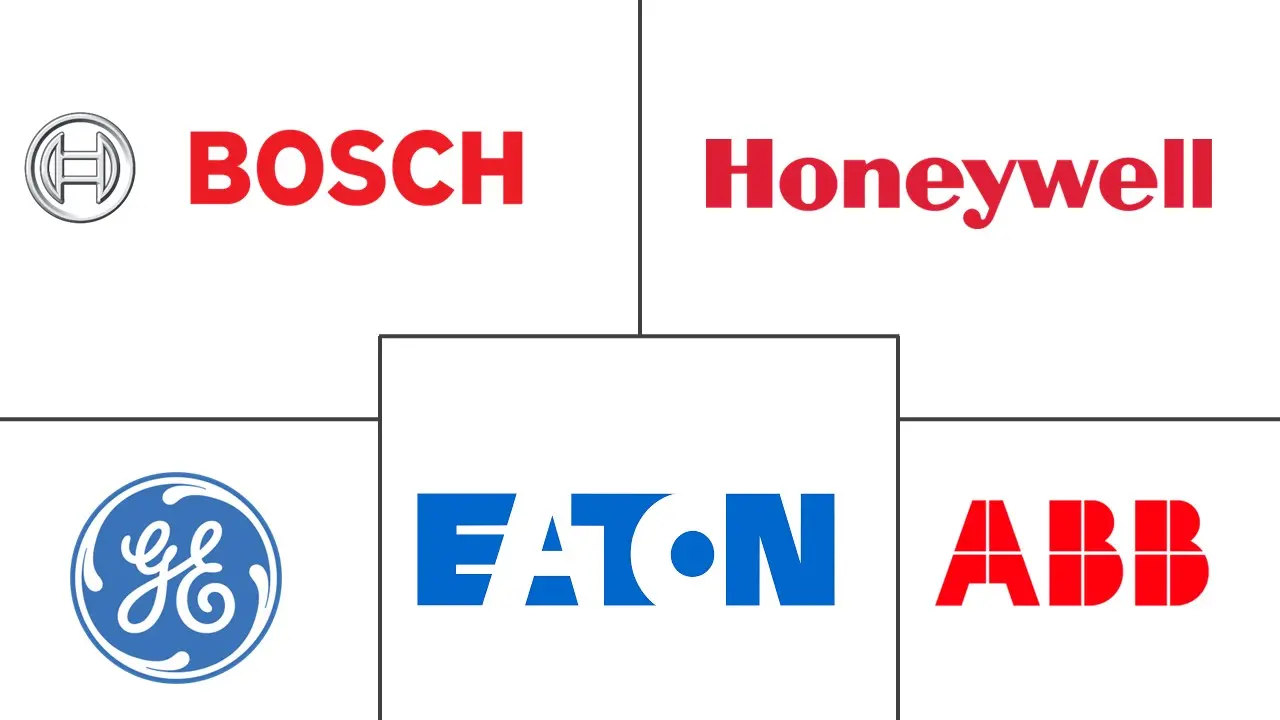Oxygen Gas Sensors Market Size and Share
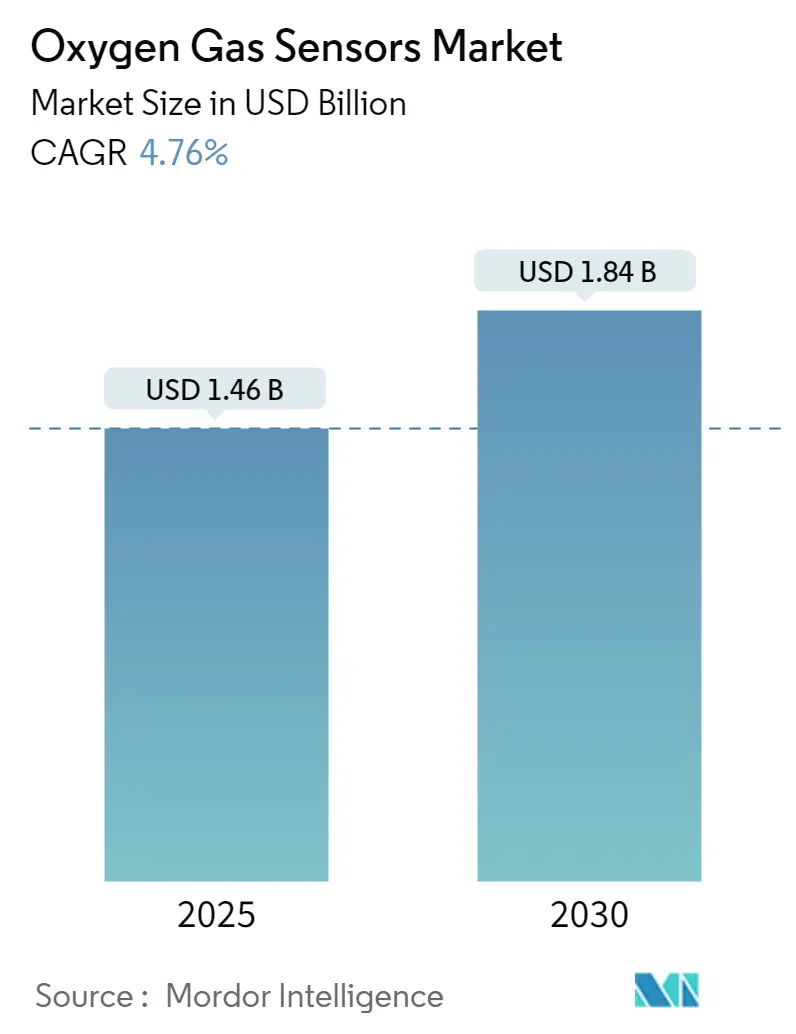
Oxygen Gas Sensors Market Analysis by Mordor Intelligence
The Oxygen Gas Sensors Market size is estimated at USD 1.46 billion in 2025, and is expected to reach USD 1.84 billion by 2030, at a CAGR of 4.76% during the forecast period (2025-2030).
- The ability to reliably measure oxygen concentration or partial pressure and warn about abnormal conditions is critical in industrial safety environments, such as mines, oil production facilities, and chemical plants. This helps in driving the growth of the market.
- The growth in the market can be attributed to the rising demand for oxygen gas sensors in a range of applications, including medical, automotive, and industrial sectors. Also, the increasing number of applications for oxygen sensors, coupled with rapid technological advancements in sensing technologies. Furthermore, the increasing awareness regarding safety and security is also driving the growth of this market.
- Moreover, environmental concerns play a crucial role in driving the growth of oxygen gas sensors. It is known that dissolved oxygen is a critical requirement for the maintenance of balanced populations of shellfish, fish, and other aquatic organisms in both estuarine and nearshore coastal waters. Various projects have been and are expected to be implemented to measure the dissolved oxygen in the water. Furthermore, ammonia, ozone, and chlorine are all toxic gases used in the decontamination stage of wastewater treatment and water purification plants. Such factors will boost the demand for oxygen gas sensors.
- Furthermore, applications ranging from adjusting the air-fuel ratio in automobiles to controlling industrial processes increasingly demand oxygen sensors, as ascertaining oxygen levels accurately is essential. For instance, in August 2022, Premier Auto Trade announced a significant expansion to its Oxygen and Air Fuel Ratio Sensors range. The PAT range now includes over 800 Direct Fit Oxygen Sensors for petrol, LPG, and diesel vehicles with a spread across Japanese, Korean, USA, and European manufacturers. This covers over 14 million vehicle applications in Australia and New Zealand, making it the most extensive range in the Australian Aftermarket.
- For instance, in August 2022, a Maharashtra Startup Got INR 32.9 million (USD 0.40 million) support from the Government for Indigenous Development of Hydrogen Gas Detecting Technology. Multi Nano Sense Technologies signed a memorandum of understanding (MoU) Technology Development Board under DST for the indigenous development of hydrogen sensing and analysis technology.
- Also, the medical application of these oxygen gas sensors is expected to experience rapid growth due to a rising need for precise devices that can measure low levels of oxygen in hospitals and other healthcare facilities. These devices are utilized for monitoring patients who have hypoxic or anoxic injuries, as well as those experiencing cardiopulmonary arrest. Additionally, they are also employed in non-invasive ventilation procedures for patients with respiratory disorders like asthma or chronic obstructive pulmonary disease (COPD).
- Companies are rolling out new products lately to remain competitive in the market. Further, Crowcon Detection Instruments Ltd launched a long-life oxygen sensor in its Gasman portable gas detector. The new sensor has an extended lifespan, which reduces the total cost of ownership and is also completely free of lead, helping organizations to comply with imminent changes to the restriction of hazardous substances (RoHS) regulations and reducing harm to the environment.
Global Oxygen Gas Sensors Market Trends and Insights
Automotive Sector to Occupy a Significant Market Demand
- Oxygen gas sensors are majorly employed in automobile exhausts to measure the amount of oxygen entering the car cylinders accurately. This instrument is used to manage the released emissions of petrol, diesel, and gas engines. The growing fleet of automotive vehicles, combined with tight government emission control regulations, is expected to stimulate automotive oxygen gas sensor sales in the future.
- Furthermore, the growing retrofitting of automotive oxygen gas sensors for vintage vehicles is expected to provide considerable opportunities for stakeholders in the coming years. In August 2022, the Indian government launched India's first double-decker electric bus in Mumbai. It is working to create an integrated electric vehicle (EV) mobility ecosystem with a low carbon footprint and high passenger density, emphasizing urban transportation reform.
- Rapid advancements in coating materials for automotive oxygen gas sensors are expected to usher in new paradigms in the worldwide automotive oxygen sensor market. Most players now use high-temperature co-fired ceramic (HTCC) green tapes with oxygen sensors to create high-strength and long-lasting vehicle sensors.
- Furthermore, in August 2022, Bosch announced a more than USD 200 million investment to produce fuel cell stacks in Anderson, S.C. A fuel cell operates by using hydrogen to generate electrical energy. As the hydrogen ions pass over the fuel cell plates, they combine with oxygen to create electricity. The only by-product is water, allowing the vehicle to run with zero local carbon emissions.
- Moreover, the industry is governed by strict policies and regulations employed by both national and international authorities, making it mandatory to utilize these systems. The industry depends on oxygen sensors to meet the emission standards governments and concerned authorities set. For instance, most gasoline-powered vehicles are equipped with catalytic converters to comply with the US Environmental Protection Agency's stricter regulation of exhaust emissions.
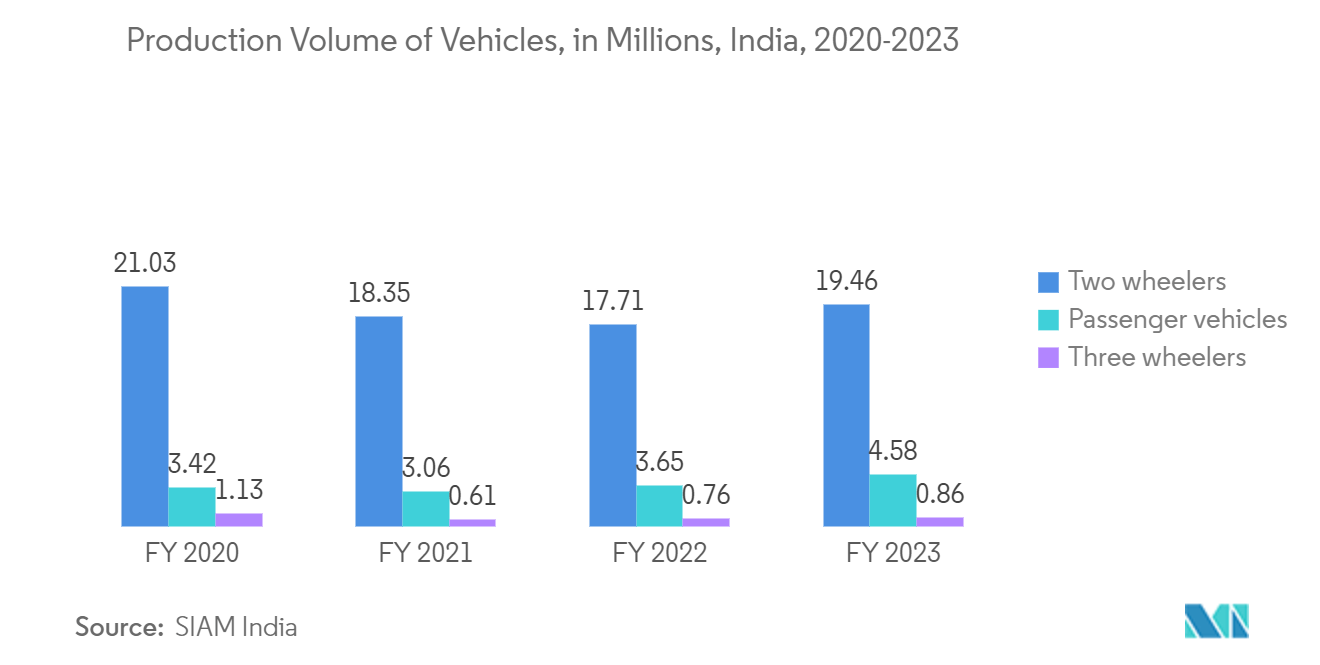
Asia-Pacific to Mark the Fastest Growth Rate
- The automotive sector in this region is expected to be the significant driver for incorporating oxygen sensors due to the increasing automobile production. According to the India Brand Equity Foundation (IBEF), the Indian passenger car market is predicted to reach a value of USD 54.84 billion by 2027. Indian automotive industry is targeting to increase the export of vehicles by five times during 2016-2026. Furthermore, in FY 2022, total automobile exports from India stood at 5,617,246.
- In addition, in March 2022, MG Motors, owned by China's SAIC Motor Corp, announced plans to raise USD 350-500 million in private equity in India to fund its future needs, including electric vehicle (EV) expansion. In addition, Two-wheeler EV maker HOP Electric Mobility, a diversified business venture of Rays Power Infra, is looking at investing INR 100 crore (USD 13.24 million) over the next two years to extend manufacturing capacity for Electric Vehicles. The increased usage of automobiles in the region consequently drives the market for oxygen gas sensors.
- Furthermore, the government of India encourages foreign investment in the automobile sector and has allowed 100% FDI under the automatic route. Furthermore, in February 2022, carmakers, including Tata Motors Ltd, Suzuki Motor Gujarat, Mahindra and Mahindra, Hyundai, and Kia India Pvt. Ltd received PLI as part of the government's plan to increase local vehicle manufacturing and attract new investment. The 20 automobile companies proposed an investment of around INR 45,000 crore (USD 5.95 billion). Government policies and initiatives in the automotive sector may further drive the studied market demand in the future.
- The region's industrial manufacturing is also set to increase due to developing economies and government initiatives like "Make in China" and "Make in India." The growth of the industrial sector is expected to boost the oxygen sensors market due to its wide applications in the industrial sector.
- The chemical and petrochemical sectors have many applications for oxygen sensors. The region is home to one of the most extensive explorations in the world. For instance, According to IBEF, under the Union Budget 2022-2023, the government allotted INR 209 crores (USD 27.43 million) to the Department of Chemicals and Petrochemicals. Furthermore, an investment of INR 8 lakh crore (USD 107.38 billion) is estimated in the Indian chemicals and petrochemicals sector by 2025.
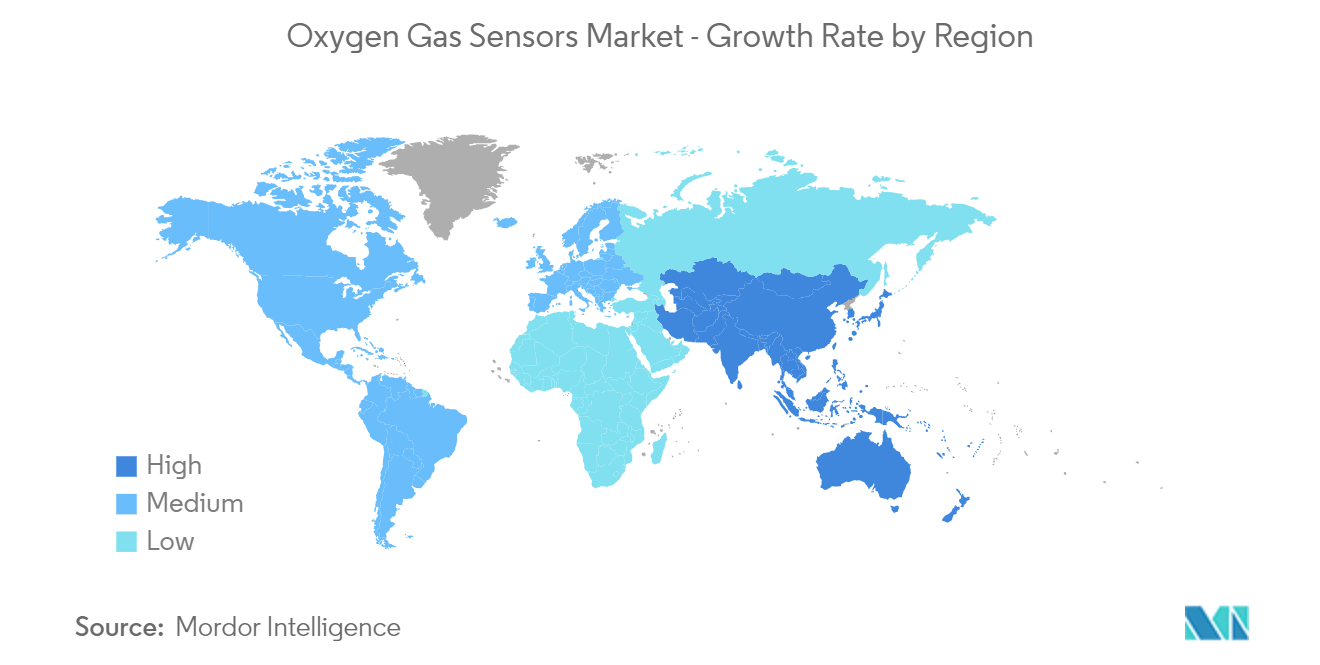
Competitive Landscape
The oxygen gas sensors market is characterized by significant fragmentation due to the presence of numerous players and relatively low entry barriers. Key industry participants, including ABB, Honeywell, Eaton, and GE, continuously engage in strategic partnerships and product development initiatives to expand their market share.
In March 2023, LogiDataTech introduced the MF420-O-Zr oxygen sensor, a cutting-edge solution designed for precise measurement of oxygen concentration in gas mixtures. This sensor employs a dynamic process that utilizes two zirconium dioxide slices to create a sealed chamber, enabling accurate linear measurement across the entire range. Additionally, the oxygen sensor features a built-in diagnostic function that monitors its performance during use and provides alerts about potential hardware or sensor issues. Consequently, there is no need for an extra oxygen sensor.
In May 2022, Angst+Pfister Sensors and Power unveiled an innovative oxygen sensor designed specifically for metal, ceramic, and polymer Additive Manufacturing procedures. These long-life digital oxygen sensors and sensor modules for Additive Manufacturing offer high ppm signal resolution and are not affected by interference from most other gases.
In March 2022, Sea-Bird Scientific announced the launch of the SBS 83 Optical Oxygen Sensor, which is set to become the standard sensor for Navis floats as part of the GO-BGC program. The GO-BGC program aims to create a network of chemical and biological sensors to monitor the health of the global oceans.
Oxygen Gas Sensors Industry Leaders
-
Robert Bosch GmbH
-
ABB Limited
-
Honeywell International Corporation
-
Eaton Corporation
-
General Electric Company
- *Disclaimer: Major Players sorted in no particular order
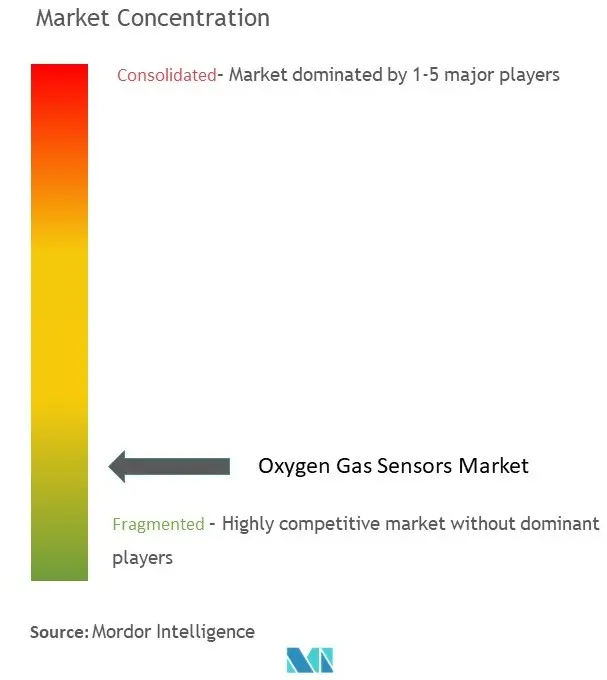
Recent Industry Developments
- May 2023: The DD-Scientific team announced an impressive expansion of their operations, marked by significant growth and a continuous influx of new customers. This sustained success has culminated in the establishment of a state-of-the-art Centre of Excellence dedicated to the production of oxygen sensors. Alongside this milestone, DD-Scientific has made substantial investments in automation and testing, solidifying its position as a leading supplier of world-class sensors. Their remarkable achievements stand tall even amidst competition from larger industry players.
- March 2023: German students from Leibniz University of Hannover selected the EC Sense TB200B-ES1-O2-25% Oxygen Gas Sensor Module for inclusion in a space experiment. This innovative experiment, destined for the International Space Station (ISS), aims to explore the intricate relationship between clover plants and rhizobia bacteria under microgravity conditions. This unique collaboration seeks to unravel the phenomenon of self-fertilization in this context.
- August 2022: Endress+Hauser unveiled a groundbreaking lineup of Liquid Analysis disinfection sensors and accompanying accessories tailored for an expanded range of applications. This release includes the CCS55D Memosens Free amperometric Bromine sensor, the CCS58D Memosens Ozone sensor, and the versatile Flowfit CYA27 assembly. The CYA27 assembly boasts unmatched flexibility, accommodating a variety of sensors, from disinfection and pH to conductivity and dissolved oxygen. In addition, it offers comprehensive flow monitoring and diagnostic indicator options, ensuring precise measurements across a spectrum of disinfection applications.
Global Oxygen Gas Sensors Market Report Scope
An oxygen sensor is an electronic device that measures the proportion of oxygen (O2) in the gas or liquid being analyzed. The most common application is to measure the exhaust-gas oxygen concentration for internal combustion engines in automobiles and other vehicles to calculate and, if required, dynamically adjust the air-fuel ratio so that catalytic converters can work optimally. It is also used to determine whether the converter is performing correctly.
The oxygen gas sensors market is segmented by type (potentiometric, amperometric, resistive, and other types), technology (infrared, catalytic, and other technologies), end-user industry (chemical and petrochemical, automotive, medical, and life sciences, industrial, water and wastewater, smart buildings, and other end-user industries), and geography (North America, Latin America, Europe, Asia-Pacific, and Middle East and Africa)
The market sizes and forecasts are provided in value (USD) for all the above segments.
| Potentiometric |
| Amperometric |
| Resistive |
| Other Types |
| Infrared |
| Catalytic |
| Other Technologies |
| Chemical and Petrochemical |
| Automotive |
| Medical and Life Sciences |
| Industrial |
| Water and Wastewater |
| Smart Buildings |
| Other End-User Industries |
| North America | United States |
| Canada | |
| Europe | Germany |
| United Kingdom | |
| France | |
| Russia | |
| Asia | China |
| Japan | |
| India | |
| South Korea | |
| Australia and New Zealand | |
| Latin America | Brazil |
| Argentina | |
| Mexico | |
| Middle East and Africa | United Arab Emirates |
| Saudi Arabia | |
| South Africa |
| By Type | Potentiometric | |
| Amperometric | ||
| Resistive | ||
| Other Types | ||
| By Technology | Infrared | |
| Catalytic | ||
| Other Technologies | ||
| By End-User Industry | Chemical and Petrochemical | |
| Automotive | ||
| Medical and Life Sciences | ||
| Industrial | ||
| Water and Wastewater | ||
| Smart Buildings | ||
| Other End-User Industries | ||
| By Geography | North America | United States |
| Canada | ||
| Europe | Germany | |
| United Kingdom | ||
| France | ||
| Russia | ||
| Asia | China | |
| Japan | ||
| India | ||
| South Korea | ||
| Australia and New Zealand | ||
| Latin America | Brazil | |
| Argentina | ||
| Mexico | ||
| Middle East and Africa | United Arab Emirates | |
| Saudi Arabia | ||
| South Africa | ||
Key Questions Answered in the Report
How big is the Oxygen Gas Sensors Market?
The Oxygen Gas Sensors Market size is expected to reach USD 1.46 billion in 2025 and grow at a CAGR of 4.76% to reach USD 1.84 billion by 2030.
What is the current Oxygen Gas Sensors Market size?
In 2025, the Oxygen Gas Sensors Market size is expected to reach USD 1.46 billion.
Who are the key players in Oxygen Gas Sensors Market?
Robert Bosch GmbH, ABB Limited, Honeywell International Corporation, Eaton Corporation and General Electric Company are the major companies operating in the Oxygen Gas Sensors Market.
Which is the fastest growing region in Oxygen Gas Sensors Market?
Asia Pacific is estimated to grow at the highest CAGR over the forecast period (2025-2030).
Which region has the biggest share in Oxygen Gas Sensors Market?
In 2025, the Asia Pacific accounts for the largest market share in Oxygen Gas Sensors Market.
What years does this Oxygen Gas Sensors Market cover, and what was the market size in 2024?
In 2024, the Oxygen Gas Sensors Market size was estimated at USD 1.39 billion. The report covers the Oxygen Gas Sensors Market historical market size for years: 2019, 2020, 2021, 2022, 2023 and 2024. The report also forecasts the Oxygen Gas Sensors Market size for years: 2025, 2026, 2027, 2028, 2029 and 2030.
Page last updated on:
Oxygen Gas Sensors Market Report
Statistics for the 2025 Oxygen Gas Sensors market share, size and revenue growth rate, created by Mordor Intelligence™ Industry Reports. Oxygen Gas Sensors analysis includes a market forecast outlook for 2025 to 2030 and historical overview. Get a sample of this industry analysis as a free report PDF download.
